Last year at the Nuremberg Interzoo, Teco launched its new chiller, the Teco TK 150, part of its new Tank Chiller Line.
Teco had already given us a preview during a visit to their office, where we had the chance to see it alongside the other chillers, one of which, the Teco TK 500, we reviewed a few months ago here.
Let’s look at the technical features of these four chillers, completely redesigned and very different from the previous line, to which the Teco TR 15 belonged (review).
The new chillers are a very different shape from what we are used to. The TR 15 was a parallelepiped, while the three new, larger TKs are almost cubic. The TK 500, 1000 and 2000 are constructed with the same base but different heights, as you can see in the following picture. The TK 150 is unique; it still is a parallelepiped like the old TR 15 but in a naked version.
Technical Features
| TK 150 | TK 500 | TK 1000 | TK 2000 | |
| Power Consumption | 150 w | 240 w | 340 w | 480 w |
| Gas Refrigerant | R134A | R134a | R134a | R134A |
| Minimum Water Flow | 400 L/h | 400 L/h | 500 L/h | 600 L/h |
| Tank Volume (water temp. 25°C – environmental temp. 30°C – thermal load 0,5 w/L) | until 150 L | until 500 L | until 1000 L | until 2000 L |
| Dimensions | 215x361x315 (h) mm | 310x310x416 (h) mm | 310x310x458 (h) mm | 310x310x500 (h) mm |
| Weight | 16,5 kg | 19,7 kg | 21,4 kg | |
| In/Out Water Connection | 1/2″ pipe, tube internal diameter 12 mm | 3/4″pipe – tube internal diameter 16mm | 3/4″pipe – tube internal diameter 16mm | 3/4″pipe – tube internal diameter 16mm |
Until now, the chillers have come in two versions: the basic TR version, which worked as a cooler only, and the accessorized TC version with an integrated heater. In this new line, the larger chillers are all equipped with a 400 w heater, leaving the small TK 150 to work exclusively as a cooler.
Manufacturing
The new Teco Tank TK 150 Aquarium Chiller has been completely redesigned, and is unlike any of the older models.
The shape remains parallelepipedal, but is totally open! Its base measures only 21×36 cm, and it is 31 cm tall. The underlying frame system also works as a cooling coil for the refrigerating gas, and is aided by a posterior fan, just like the older models.
Inside the structure, we can see the compressor. The convective hot air movement and the fan help dissipate the coil’s heat, which, for construction reasons, doesn’t need an air filter.
This new system is patented, and Teco named it Teco Body – Condenser System.
The in/out water pipes are positioned at the top and bottom of the unit, and they have a 12 mm diameter (1/2″), smaller than the larger-sized chillers’ 3/4″ pipes.
To fasten the tubes to the pipe joints, two cable ties are included. They are a bit hard to use, but they definitely secure the tubes, guaranteeing a completely watertight seal.
The red liquid crystal display has been enormously improved, in comparison to the previous models, it’s a shame we cannot appreciate it in the picture above (it’s off).
To review, just watch the video below; we created it especially for the new Teco Tank Chiller Line, and it covers the TK 150 and the three more powerful units.
The Probe
One notable detail is the position of the temperature probe. Teco placed the probe in the inflow pipe to make sure that the temperature measured is the actual one from the tank, which hasn’t been cooled yet. This is one of the reasons why we did not notice a drop in temperature on the display shortly after turning the chiller on.
If the probe was located in the outflow pipe, it would read a lower temperature shortly after the chiller is on, but it would not be the same as the temperature in the tank. This could lead to frequent on/off cycles of the unit without an actual lowering of the tank temperature.
Installation
The installation is very easy, we just need to connect the in/out tubes and then connect the inflow tube to a return pump (or a deviation of the existing return pump).
Before each use, I strongly recommend a cleaning cycle: remove it from the sump and place the pump and tubes in a water bucket with muriatic acid (hydrogen chloride) at 5% concentration, then let everything run for 10 minutes to dissolve any trace of limescale. after 10 minutes, wash everything out with tap water, no need to use RO water.
When set up with an adequate return pump – Teco recommends a minimum of 400 l/h – there is very low noise overall, most of the noise comes from the fan rather than the compressor.
The display constantly shows the temperature measured from the inflow pipe, with a one-decimal-place accuracy. We can set the control temperature that accurately as well. The chiller starts working at one degree deviation from our desired temperature. We can modify this to half degree by pressing and holding the set button, but Teco strongly advises against this, as it could lead to a series of on/off cycles that could compromise the compressor. It’s best for the refrigerator to be on for hours at a time rather than being switched on and off every 15 minutes.
To set the temperature we just need to push the “set” button for 3 seconds while the chiller is on, and when the display starts blinking we can set the temperature using the two arrow buttons.
The Trial
I have been using the Teco Tank TK 150 for a long while on my SPS 400 liter tank, even though it was heavily infested by dinoflagellates.
As you can see, the tank was lighted by 3 Ecotech Marine Radions, two G2 and one G2 PRO, for a 400 liter tank with a 1.5 w per liter thermal capacity at the lamps’ maximum power.
It was a challenging trial for the small TK 150, made even more difficult by the heat produced by 3 LED lamps with a maximum power of 170w each, for a total of 510 watts! That is why the system was set to work in conjunction with two Teco E-Chill fans(review); they worked as a first cooling step, and the TK 150 turned on when the E-Chill was not sufficient.
Even in Rimini, Italy, where the summer temperature can easily go over 30°C, the system didn’t have any problems.
I set the Teco E-Chill at 26,6 degrees, so the tank temperature would reach 27,5 degrees before the fan starts working, while the Teco TK 150 was set at 27,5° so it would switch on at 28,5 degrees and work in synergy with the fans until the temperature was lowered to 26,5° for the E-Chill and 27,5° for the TK 150 respectively.
When set up this way, the fans ran most of the time, which consumes less electricity, but when needed, in case of particularly high temperatures, the chiller helps them. On its own, the TK 150 would be too small, but the two units working together do an efficient job. This way I saved money by buying a smaller chiller and I have two cooling systems which can work independently in case of any malfunctions.
I can also switch the units’ functioning order by putting the chiller before the fans; with this configuration, I can avoid the need to top-off, helpful for when I’m away on vacation.
This chiller has an electrical refrigerating power of only 150w, but it manages to keep a 400 L tank cool in a 30°+ environment, when used with the Teco E-Chill fans.
How it works
As I said before, the controller has an intervention cycle of 1°C; when set at 27°C, the chiller would start working at the temperature set plus 1°C (28°C) and it would turn off once the water temperature reaches the 27°C. The temperature reading is accurate to the first decimal place, allowing us to read and follow the decreasing tank temperature.
The 1°C cycle could seem a bit too wide, but this happens only if the cooler is too large for the tank, in which case we would have more frequent oscillations because of its remarkable cooling power. In that case, one can always set the temperature to a half degree range.
The Noise
One of the biggest worry for all aquarists is the noise, and most chillers are known to be not very silent. Apart from those who can afford to install this accessory outside their home, or in a dedicated room (here I’d like to remember our friend Lumaz‘s project) the noise becomes a very important characteristic to consider.
In my case, the chiller was installed inside the aquarium cabinet.
To measure the noise I used, as always, the professional phonometer VOLTCRAFT 320, digital phonometer IEC 651 Type II which is sufficiently accurate for this project. Considering the type of noise we needed to measure, all the measurements were recorded with dBA wave attenuation. The measurements were taken with closed windows, the phonometer placed on a tripod 1 meter away from the unit with minimum intervals of 120 seconds between measurements, with the following results:
Environmental noise with the skimmer not functioning.
Skimmer functioning, chiller off, cabinet doors closed.
Skimmer functioning, chiller on, cabinet doors closed.
Skimmer on, chiller on, cabinet doors open.
Let’s compare these measurements with other chillers tested in the past:
| Measurement Conditions | Teco TK 150 | Teco TK 500 | Teco TR15 | Aquamedic Titan 250 |
| Functioning aquarium | 40,4 dB | 46 dB | 41,5 dB | 48,7 dB |
| Functioning aquarium and chiller | 42,4 dB | 51,6 dB | 53,8 dB | 52,1 dB |
| Environmental noise | 38,9 dB | 40,4 dB | 35,0 dB | 35,8 dB |
The measurements were taken from different tank set-ups, but still, it is clearly evident that the TK 150 is the most silent chiller. The difference is so relevant that we can almost say that the noise is not audible.
In fact, the Teco TK 150 only added +2dB to the system when on, compared to the 5,6dB of the TK 500, the 12,3dB of the older TR 15, and the 3,4 dB of the Titan 250.
The difference was not completely unexpected, as the other chillers are much stronger, but this really is a nearly-silent chiller, so silent that, while using it, I sometimes had to go and check that it was actually on.
You should consider the environmental conditions in which the measurements were taken: in other situations with more or less reinforcements of the various noise frequencies, the noise measured could be very different.
Power consumption
Choosing a chiller also includes evaluating its power consumption. We know too well how our tanks’ power consumption impacts the electricity bill… so we should consider this characteristic before adding any accessory to our layout.
The TK 150 has a refrigerating power of 150 watt, a really low absolute and relative value, so the energy consumption won’t be very high.
Regardless, the cooler’s power consumption is much lower than what we’d expect. 150 watts is really not much, even considering the warmer seasons when the chiller could be functioning up to 8 hours per day, it still translates to around 32 cent spent.
Important: water flow inside the chiller and pump choice.
The water velocity inside the refrigerator is a very important value. One may think that when the flow is slower, the water quantity going through the chiller would be lower, but become more refrigerated.
This reasoning, when talking about tank chillers of any brand, is simply wrong.
But we must consider the refrigerator efficiency, which grows with increasing water temperature. In other words; when the water enters the chiller it is cooled down, if it has a slow flow, it would be cooler sooner, and then the chiller would need to work much harder to cool it down even more; but if the water flow is higher, the water will be cooled but not too much, and the chiller intervention would be maximized.
That is to say that the higher the flow, or the more powerful the pump, the better the chiller efficiency. This would lead to the water cooled down more rapidly and believe me, the difference is not small – the overall efficiency can actually double.
Teco recommends using a pump with an affective rate of at least 400 liters per hour, but we could use a much stronger pump to obtain many benefits. In my tank, I used the Sicce Syncra 1.5 with a rate of 1350l/h (reviewed here) and a power consumption of 23 w (around 0.15 € per day in Italy).
To those who can install the refrigerator outside the tank room, I recommend measuring the real rate of the return water in the sump, as the distance and the curves in the tubes would reduce the real flow rate. I also recommend protecting it from harsh conditions and from direct sunlight, which could impede its performance and also ruin the unit itself; Teco markets this as an inside unit.
Useful Tips
It is very important to set this chiller up correctly and keep it in the right conditions. One of the most frequent criticisms is that the chiller cools down the sump water quickly but that the water is not distributed in the sump quickly and constantly enough.
To prevent this issue, the water flow entering the refrigerator must be equal to that of the return pump to the tank. Unfortunately, we cannot just compare the technical features of the pumps, as they are usually lower than the ones stated. (I recommend you read this article: how to choose the return pump)
Most importantly, for optimal functioning, the chiller pump should be positioned right under the water coming from the tank, so that it would always work on this warm water, and avoid the risk of cooling down the sump water too much but not returning it as cool to the tank.
Creative alternatives: the same pump could be used for the chiller and to return the water to the tank, alternatively, the outflow tube of the chiller could be installed directly in the tank like it was a second return pump. In the first case, we’d definitely need to boost the pump to counterbalance the loss of prevalence caused by the refrigerator, in the second we would still need to use a very strong pump to function as a return pump as well.
I obviously prefer the first method described, a two-prong circuit in sump.
Conclusions
Teco Tank TK 150 can be found in Italy at the maximum price of € 440. A price that reflects the unit value and is not excessive, though real price can (obviously) vary from shop to shop.
The chiller’s construction is exquisite and flawless, and we really liked the Teco Body – Condenser System design, where the chiller body is the actual cooling unit; this also totally eliminates maintenance apart from assembling and reassembling.
We know that our conditions are not within the standards, as we had LED lighting, cooling fans, and a 400 L tank, but we loved the TK 150 and it worked just how we wanted it to. During the 15 days we left it and went on holiday, it managed the whole tank and the values remained unchanged.
As with the other units in the Teco line, the cooling coil is in titanium and the chiller has a protective fuse in case of short circuit or excess current.
The manufacturing quality is, as always, at the top level and we don’t have any complaints about the plastic choices. If we are pressed to find something wrong, we’d mention that the in & out tubes are smaller than all other TKs, 1/2″ instead of the more useful 3/4″.
With the help of a tank chiller, Teco or any other, water evaporation is reduced to a minimum, which means: less need to top-off water, resulting in longer autonomy in case of holiday or other long periods of absence, and less water waste as a result of less RO water needed. All these benefits lead to a more stable tank water temperature and it comes at an “affordable” price, if we consider that 8 hours functioning per day for 4 months of summer (June-September) in Italy would result in around 39 euros in total (8h*150w*120gg/1000*0.27€/kwh).
In our opinion, the suggested tank size of 150 liters for this chiller is rather small, with LED lighting we think it could work on up to 200 liters of water with an adequate return pump in order to maximize the refrigerator efficiency.
Obviously, the cooling power of the refrigerator is influenced by the environmental temperature and by the temperature we set for the tank.
Nevertheless, the chiller is always a suggested item to buy, and the Teco TK 150 is a small but big-hearted refrigerator, so silent we almost can’t hear it, very well designed and with a good efficiency.
The only negative point is a consequence of its design, it is difficult to make an opening in the cabinet for direct air exchange, it was easier with the TK 500, 1000, and 2000; you can read about it in our TK 500 review.
We’d like to thank Teco for providing us with the TK 150 chiller for this trial.
[Translated by Giorgia Lombardi]

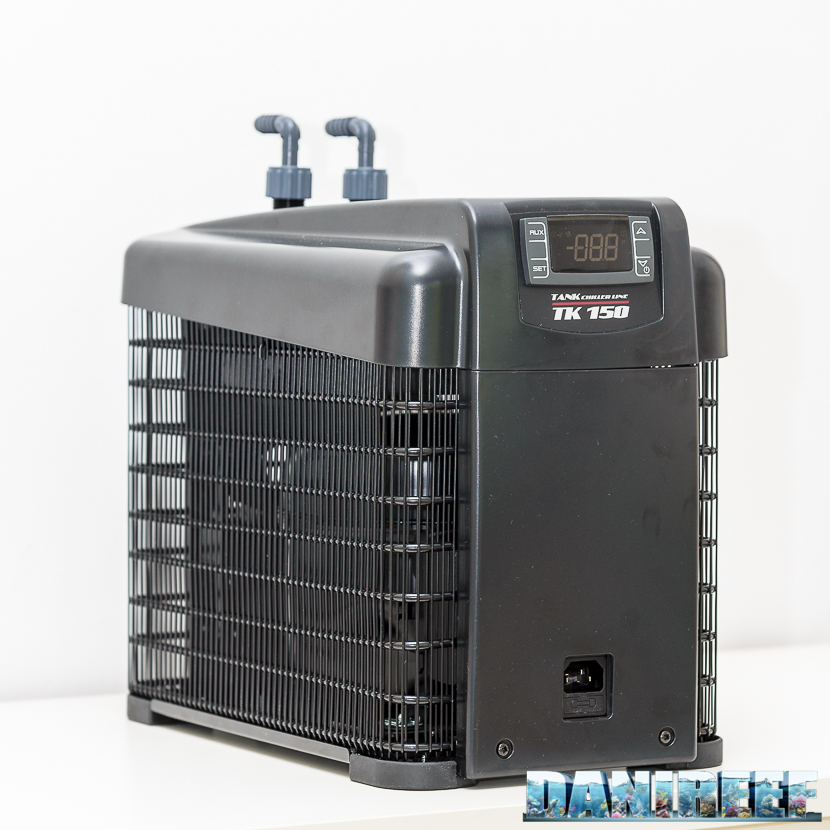
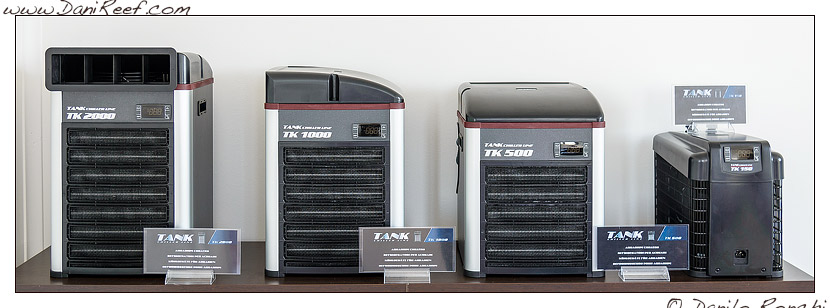
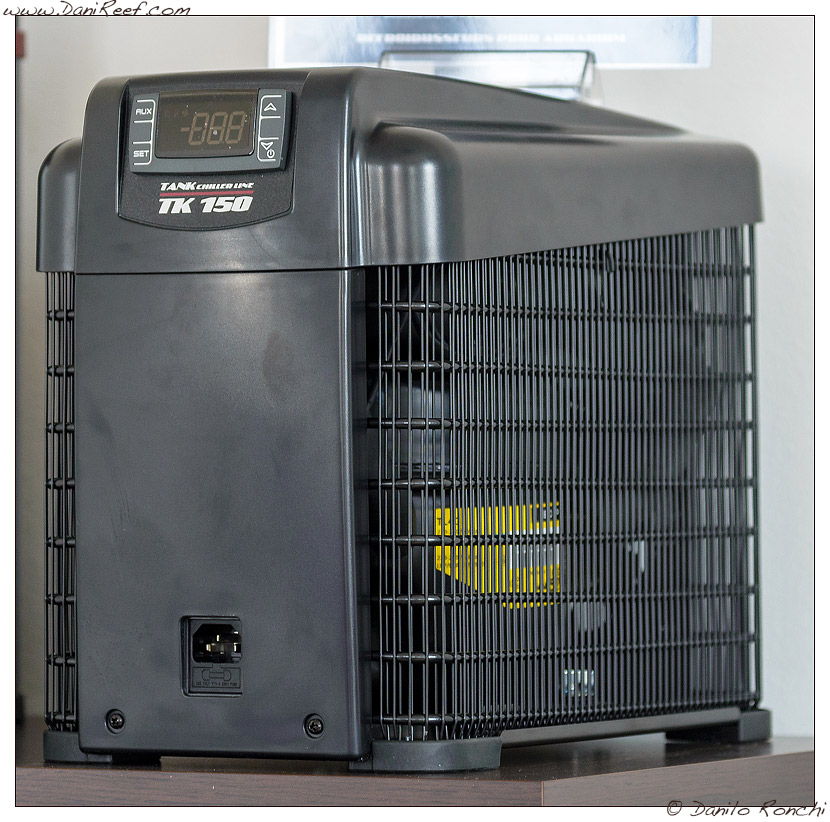
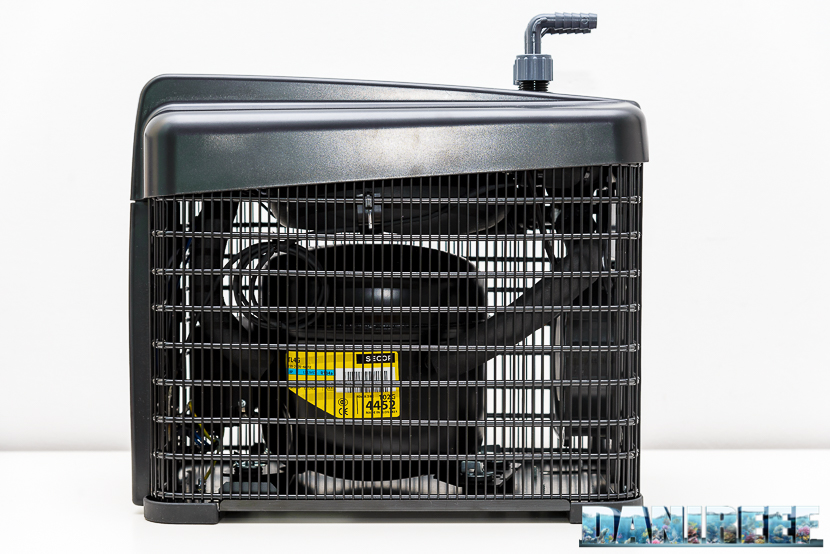
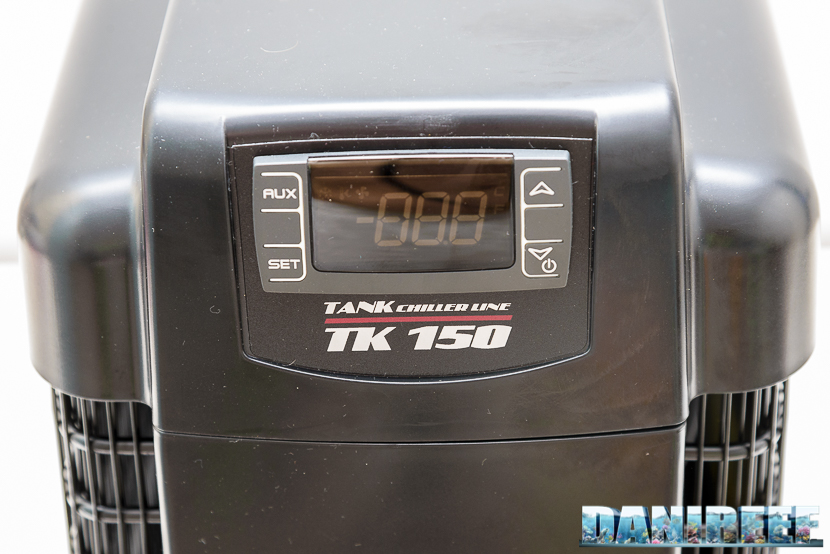
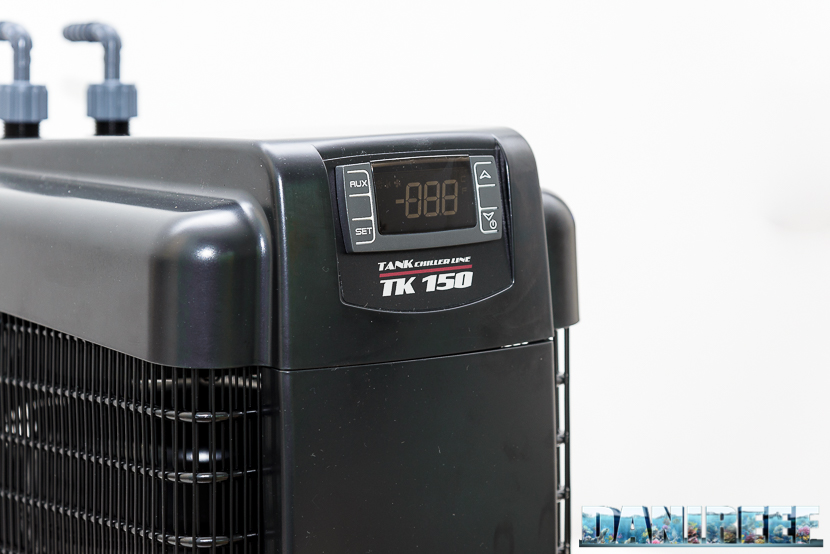






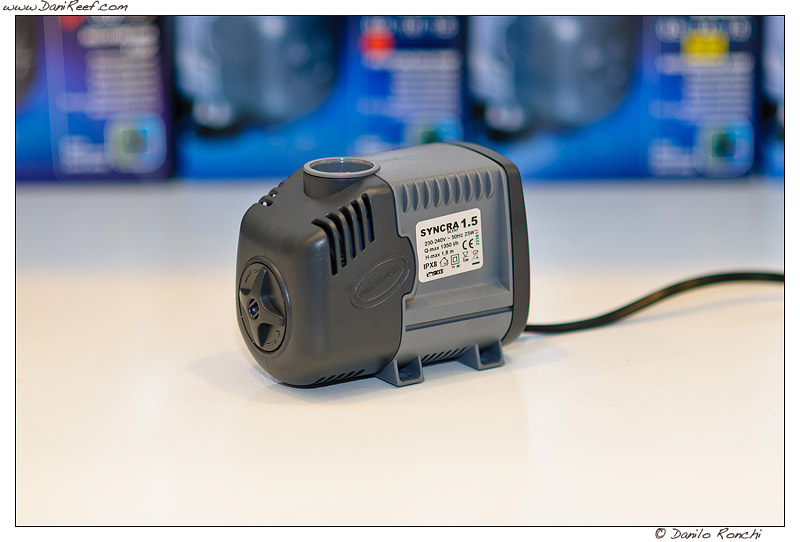
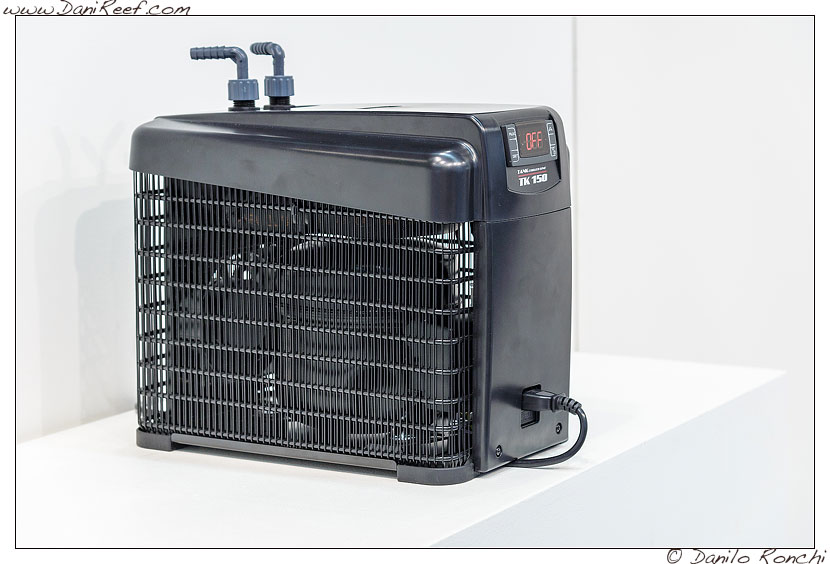
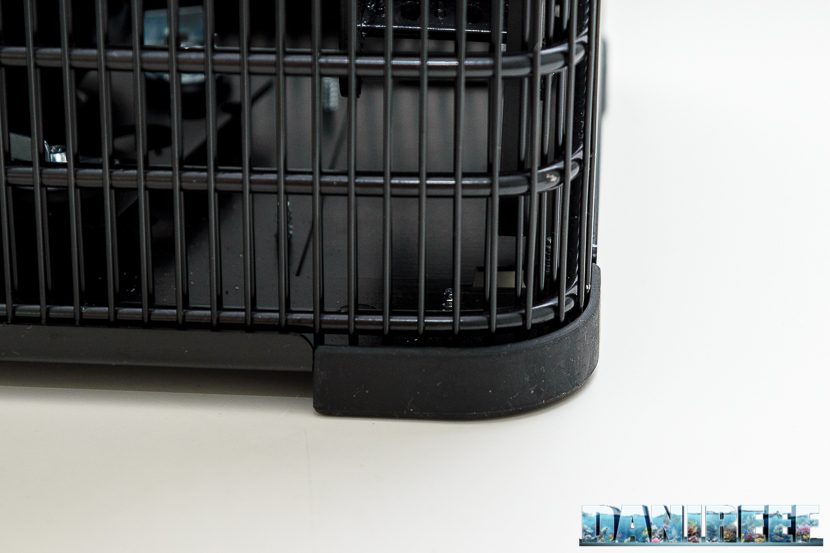
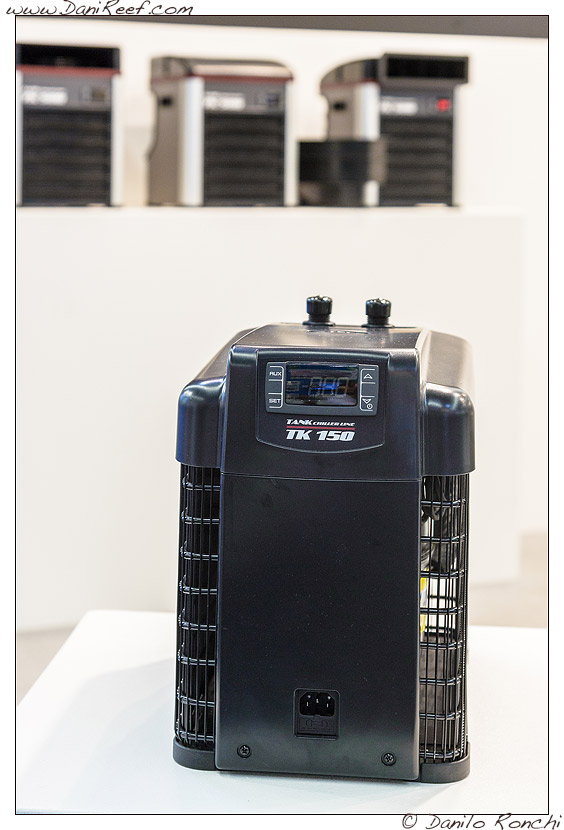
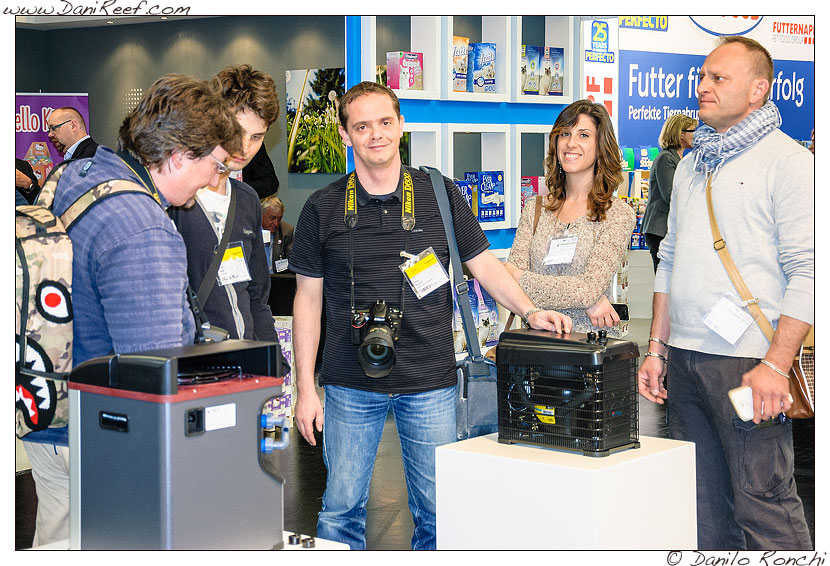









A quick Teco TK 150 chiller review
It was 50 deg C in my garage here in Arabian Ranches this afternoon, and have the new Juwel RIO 300 setup as a planted tank.
The setup was done on Aug 21st 2016.
I have not been able to get the temperature below 29.2 degrees, and it usually hovers around 29.8-30.2 C.
Despite the room temp being around 25-27 degrees.
Starting the UV light raises the temp 1 deg C.
Too hot for plants.
Today I purchased the Teco TK 150 chiller from the EXCELLENT guys at ThinkFish.
This is a chiller usually used for smaller tanks than mine. My physical tank size is appx 330 litres, minus 72 litres ADA Amazonia (new) aquasoil, three roots and four rocks. So I guesstimate my water volume to be appx. 250-270 litres (66-70 US Gallons).
One review I read before purchasing is this one:
https://reefs.com/2015/08/18/teco-tank-tk-500-king-chiller/
http://www.danireef.com/…/chiller-teco-tank-tk-150-depth-r…/
Info on unit:
https://www.tecous.com/chillers/tk-150/
——————-
It took 3 hours to bring the temp down from 29.8 degrees to the selected 27.5 degrees.
No UV light running, but three canisters running in the cabinets, lights (LED) on for one of those 3 hours.
My filters:
– JBL CristalProfi e1901 Greenline canister filter
36W power consumption
1900l/h & 15 l filter volume. 4 year warranty.
Size: 200 x 235 x 564 mm incl. hose connection
– EHEIM professional 3 1200XLT canister filter
25W power consumption w 500W heater
1700l/h & 12 litre filter volume, 1.5 litre pre-filter & 25l container volume
Size: 330 x 330 x 567 mm
Hose 16/22 mm
– EHEIM Classic 350 (2215) canister filter
15W power consumption
620l/h & 4 litre filter volume, 4.8 litre container volume
Size: 185 Ø x 370 mm
Hose 12/16 mm
I have the chiller hooked up to my EHEIM Classic 350, then from the chiller to the UV light (JBL AquaCristal UV-C 18 W UV Light) then back to the tank.
This is in Dubai, UAE
I wonder if you can use a TK150 to kyal a tank of 50 liters where the coolant is rapeseed oil. will the oil flow too slowly through the cooler and can you recommend a pump that can handle the oil.
Hi, I really don’t know… I think you have to ask directly to Teco for this question.